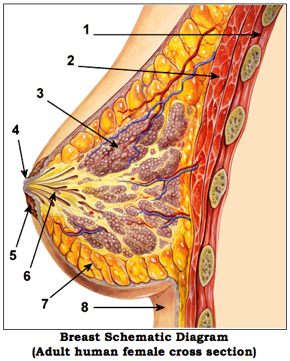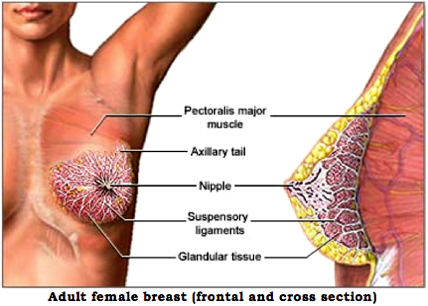Let’s Talk!
Cancer is one of the most feared diseases of our time. Depending on your sex, different organs can be affected. In North America, breast cancer is the most commonly diagnosed cancer in women and the second most lethal cancer after lung cancer. In 2009, an estimated 22,700 Canadian women were diagnosed with breast cancer, and 5,400 died from it. One in 9 women will develop breast cancer in her lifetime, and one in 28 will not survive.
Breasts are modified sweat glands that can produce milk in women. They are considered secondary sexual organs because they are not essential for reproduction. The breast tissue extends from the armpit up to the collarbone and across to the breastbone in the middle of the chest (see diagram below). Breasts rest on the chest muscles that cover the ribs and are made of glands, ducts (thin tubes), and fatty tissue.
Lobules are a group of glands that produce milk (see diagram below). From the lobules, milk travels through a network of ducts to the nipple. The nipple is in the center of a darker area of the skin (areola). Fatty tissue surrounds and protects the lobules and ducts.
 Legend: 1. Chest wall 2. Pectoralis muscles 3. Lobules 4. Nipple
Legend: 1. Chest wall 2. Pectoralis muscles 3. Lobules 4. Nipple
5. Areola 6.Duct 7. Fatty tissue 8. Skin
There are lymph vessels and lymph nodes (small bean-shaped glands) in the breasts. These vessels and nodes are part of the lymphatic system, which helps fight infection. Lymph fluid flows through the lymph vessels to the lymph nodes. The nodes trap viruses, bacteria, cancer cells, or other toxic substances. Lymph nodes are found near the breast, under the arm, near the collarbone, and behind the breastbone (chest).
Cancer is the result of cells that divide and grow uncontrollably. Breast cancer can start in the ducts (ductal carcinoma) or in the lobules (lobular carcinoma). The most common type of breast cancer is ductal carcinoma. The breast tissue is sensitive to the female hormones estrogen and progesterone—this is the reason why only 1% of breast cancers are found in males.
Scientists still do not know what causes breast cancer, but many risk factors have been identified:
• Sex: 99% of breast cancer affects women
• Age: being over 50 years old
• Family history of breast cancer
• History of abnormal breast cells
• Giving birth for the first time after age 30
• Never breastfeeding
• Dense breast tissue
• Exposure of the breast to high levels of radiation (i.e., x-ray) before the age of two
• Women after menopause who are overweight
• Early menstruation (before the age of 12)
• Late menopause (after age 55)
• Taking hormone replacement therapy
• Long-term use of birth control pills
• High alcohol consumption (more than one drink/day)
• Smoking
• Low physical activity
Breast cancer is often a very traumatizing disease. The good news is that cancer takes many years to develop, and lowering your risks is possible. Besides examining your breast every month, here are lesser-known lifestyle choices to avoid/limit:
• Night shifts: night workers tend to produce less melatonin, a hormone that helps prevent some of the steps leading to cancer.
• Red meat: women should eat red meat a maximum of two times per week.
• Saturated fat/trans fat: saturated fats are solid at room temperature (i.e., animal fat). Trans fats (created by hydrogenated oils) are found in pastries and crackers. Limit the consumption of both types of fat.
• Soybean: soy (the fruit of soybean) mimics estrogen and stimulates the growth of breast cancer cells. Eat a maximum of two servings per day.
Thousands of Canadian women will be diagnosed with breast cancer this year. Fortunately, effective treatment will enable the vast majority of these women to survive this disease. It takes many years to develop breast cancer, and the best course of action may be prevention by lowering your risks. Appropriate lifestyle changes could ultimately mean keeping the second most common cancer at bay.
Literary Truths
Here are some supplements and food items you can add to your diet to reduce your risks of breast cancer:
- Vitamin D: fair-skinned people need 5-30 minutes of sunlight 2-3 times per week from 10:00 am to 3:00 pm to produce enough vitamin D. Darkest-skinned individuals may need up to two hours of sunlight exposure each time. For people who are concerned about skin cancer risks, they can take supplements of 1000 IU of active Vitamin D3 per day.
- Fiber: increase your daily intake of fiber from whole grain and whole wheat foods to 20 g per day.
- Omega-3 fatty acids: fatty fish such as salmon, mackerel, and herring are good sources of omega-3 fatty acids. It is recommended to have at least two servings of 3.5 ounces of cooked fish per week.
- Pomegranate seed oil: pomegranate contains powerful anti-oxidants, and the oil can cause breast cancer cells to self-destruct.
- Green tea: this type of tea contains antioxidants (polyphenols) that prevent cancer cells from dividing.
- Cruciferous vegetables: broccoli, cabbage, Brussels sprouts, and cauliflower contain a chemical called indole-3-carbinol that changes cancer-promoting estrogen into a more protective type.
- Blueberries and grapes: a compound called pterostilbene found in blueberries and grapes deactivates an enzyme (P450) linked to cancer.
- White button mushroom: the common mushroom found in the supermarket inhibits an enzyme (aromatase) that is needed for estrogen production by the body. Estrogen feeds the growth of breast tumors. It is recommended to eat 100g (or seven average mushrooms) per day.
Truth in Motion
References
Breast Anatomy Diagram
Diet Tips for Breast Cancer Prevention
Female Breast Diagram
Hall, Sheri. “Lose the weight, lower the risk: Human Ecology program fights breast cancer by addressing obesity.” Human Ecology 37.1 (2009): 8.
Health Canada – Breast Cancer
How to Eat Healthy to Help Prevent Breast Cancer
Hudson, Tori. “Screening mammography: what to do now?” Townsend Letter Apr. 2010: 90.
Kanthan, Rani, et al. “Expression of cell cycle proteins in male breast carcinoma.” World Journal of Surgical Oncology 8 (2010): 10.
Kim, Jeongseon, et al. “Fatty fish and fish omega-3 fatty acid intakes decrease the breast cancer risk: a case-control study.” BMC Cancer 9 (2009): 216.
Klotter, Jule. “Statistics, mammography, and informed choice.” Townsend Letter Apr. 2010: 31.
Moss, Ralph. “War on cancer.” Townsend Letter Feb.-Mar. 2010: 40.
Perry, Sarah. “Breast self-examination no longer recommended: breast self-examination is no longer recommended as an option for early detection of breast cancer. Rather, women are being encouraged to be “breast aware.” Kai Tiaki: Nursing New Zealand 15.2 (2009): 12.
Pons, Luis. “Pterostilbene’s healthy potential: berry compound may inhibit breast cancer and heart disease.” Agricultural Research 54.11-12 (2006): 6.
Psychology Today, August 2009 issue
Public Health Agency of Canada – Breast Cancer
“Raised alert over cancer risk to night-shift workers.” The Safety & Health Practitioner 27.4 (2009): 7.
Statistics Canada – Cancers

I’m happy that I discovered this page. I’ll bookmark it.
Excellent article and easy to understand explanation. How do I go about getting permission to post part of the article in my upcoming newsletter? Giving proper credit to you the author and link to the site would not be a problem.
Thank you for visiting my blog and appreciating its content. However, as already mentioned on my website:
*No part of this website’s content may be used or reproduced in any manner whatsoever except by a reviewer who may quote brief passages in a review. Only short referenced quotes (i.e., a few sentences) or paraphrasing the ideas are acceptable options. The other alternative is to add a direct link on another website to this website.*
Regards,
J.M.
I learned a lot from your website, and I bookmarked it. I’ll be back soon for some more good articles.